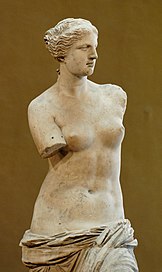Body shape
This article needs additional citations for verification. (August 2015) |

| Part of a series on |
| Human body weight |
|---|
Human body shape is a complex phenomenon with sophisticated detail and function. The general shape or figure of a person is defined mainly by the molding of skeletal structures, as well as the distribution of muscles and fat.[1] Skeletal structure grows and changes only up to the point at which a human reaches adulthood and remains essentially the same for the rest of their life. Growth is usually completed between the ages of 13 and 18, at which time the epiphyseal plates of long bones close, allowing no further growth (see Human skeleton).[2]
Many aspects of body shape vary with gender and the female body shape especially has a complicated cultural history. The science of measuring and assessing body shape is called anthropometry.
Physiology
During
Facial features
Due to the action of testosterone, males may develop these facial-bone features during puberty:
- A more prominent brow bone (bone across the centre of the forehead from around the middle of eyebrow across to the middle of the other) and a larger nose bone.[3]
- A heavier jaw.
- A high facial width-to-height ratio.[4] However some studies dispute this, and testosterone reduces cheekbone prominence in males.[5]
- A more prominent chin.
Because females have around 1/4 the amount of testosterone of a male, the testosterone-dependent features do not develop to the same extent, and female faces are generally more similar to those of pre-pubertal children.
Skeletal structure
Skeletal structure frames the overall shape of the body and does not alter much after maturity. Males are, on average, taller, but body shape may be analyzed after normalizing with respect to height. The length of each bone is constant, but the joint angle will change as the bone moves.[6]
Female traits
Widening of the
Male traits

Widening of the
]Fat distribution, muscles and tissues


Body shape is affected by body
structure, muscles and fat distribution may change from time to time, depending on food habits, exercises and hormone levels.Fat distribution
Estrogen causes fat to be stored in the
Estrogen increases fat storage in the body, which results in more fat stored in the female body.[17] Body fat percentage guidelines are higher for females, [18] as this may serve as an energy reserve for pregnancy. [19] Males generally deposit fat around waists and abdomens (producing an "apple shape").[citation needed]
Muscles
Breasts
Females have
Weight
Being
Body posture and gait
Body shape has effects on body
Impact on health
According to the Heart and Stroke Foundation of Canada, those people with a larger waist (apple shaped) have higher health risks than those who carry excess weight on the hips and thighs (pear shaped). People with apple shaped bodies who carry excess weight are at greater risk of high blood pressure, Type 2 diabetes and high cholesterol.[28] The United Kingdom's National Institute for Health and Care Excellence advises that a person's waist-to-height ratio (WtHR) should not exceed 0.5, and that this rule applies to everyone from the age of five and is irrespective of gender, ethnicity or BMI.[29]
Fitness and exercise
Different forms of exercises are practiced for the fitness of the body and also for health. It is a common belief that targeted exercise reduces fat in specific parts of the body —for example, that exercising muscles around the belly reduces fat in the belly. This, however, is now proven to be a misconception; these exercises may change body shape by improving muscle tone but any fat reduction is not specific to the locale. Spot reduction exercises are not useful unless you plan proper exercise regime to lose overall calories. But exercising reduces fat throughout the body, and where fat is stored depends on hormones. Liposuction is surgery commonly used in developed societies to remove fat from the body.
Social and cultural ideals
The general body shapes of female and male bodies both have significant social and cultural symbolism. Physical attractiveness is closely associated with traits that are considered typical of either sex.[34] The body mass index (BMI), waist-to-hip ratio, and especially waist-to-chest ratio in men have been shown in studies to rank as overall more desirable to women. To be deemed to have an "athletic built"/build[35] is usually a reference to wide shoulders, a muscular upper body and well-developed upper-arm muscles which are all traits closely associated with masculinity, similarly to other specifics of the male sex, like beards. These traits are seen more sexually attractive to women and also associated with higher intelligence, good leadership qualities and better health.[36]
Terminology
Classifications of female body sizes are mainly based on the circumference of the bust–waist–hip (BWH), as in 36–24–36 (inches) respectively. In this case, the waist–hip ratio is 24/36 = 0.67. Many terms or classifications are used to describe body shape types:
- V shape: Males tend to have proportionally smaller buttocks, bigger chests and wider shoulders, wider latissimus dorsi and a small waist which makes for a V-shape of the torso.
- Hourglass shape: The female body is significantly narrower in the waist both in front view and profile view. The waist is narrower than the chest region due to the breasts, and narrower than the hip region due to the width of the buttocks, which results in an hourglass shape.
- Apple: The stomach region is wider than the hip section, mainly in males.
- Pear or spoon or bell: The hip section is wider than the upper body, mainly in females.[citation needed]
- Rectangle or straight or banana: The hip, waist, and shoulder sections are relatively similar.
See also
- Body image – Aesthetic perception of one's own body
- Body proportions – Proportions of the human body in art
- Body mass index – Relative weight based on mass and height (BMI)
- Bust/waist/hip measurements – Measures used for fitting clothing ("Vital statistics")
- Dad bod – Slang term for a body shape particular to middle-aged men
- Female body shape – Cumulative product of the human female skeletal structure and distribution of muscle and fat
- Human gait – A pattern of limb movements made during locomotion
- Human physical appearance – Look, outward phenotype
- Phenotype – Composite of the organism's observable characteristics or traits
- List of human positions – Physical configurations of the human body
- Human skeleton – Internal framework of the human body
- Sex differences in humans – Difference between males and females
- Sexual dimorphism – Condition where males and females exhibit different characteristics
- Somatotype and constitutional psychology – Taxonomy to categorize human physiques
- Eugenics – Aim to improve perceived human genetic quality (discredited fringe theory)
- Waist–hip ratio
- Waist-to-height ratio
Notes
References
- ^ a b c Singh D (2007). "An Evolutionary Theory of Female Physical Attractiveness". Psi Chi. The National Honor Society in Psychology. Archived from the original on 2007-07-05. Retrieved 2011-10-09.
- ^ "Lateral Synovial Joint Loading Explained In Simple English". Archived from the original on 2021-01-26. Retrieved 2021-01-31.
- S2CID 204999982.
- ^ Holden C (August 20, 2008). "The Face of Aggression". Science. Retrieved 15 January 2021.
- PMID 27078636.
"Specifically, facial width/lower face height gets smaller (i.e., the lower face grows more than the width of the face), cheekbone prominence gets smaller (i.e., the width of the face at the mouth—a measure of relative jaw width—grows more than the width of the cheekbones), and lower face height/full face height gets larger (i.e., facial growth is focused in the lower face) as male adolescents develop. These results are consistent with the craniofacial literature that documents pronounced growth in the male mandible under the influence of exogenous T [51] and during puberty [83–85]. Similarly, the association between T and these mandible-inclusive facial ratios accords with Lefevre et al. [16], who found significant sexual dimorphism in these three ratios, but no adult sex difference in fWHR." See Table 1 and Figure 2 for cheekbone relation to testosterone levels.
- ISSN 0955-6222.
- ^ a b "Reproductive Anatomy and Physiology". The Harriet and Robert Heilbrunn Department of Population and Family Health. Columbia University Mailman School of Public Health. Retrieved 2011-10-09.
Secondary sexual characteristics occur as part of the pubertal process
- Sexual dimorphism in Hips
- ISBN 0-340-76044-3.
- ^ "Clues To Mysteries Of Physical Attractiveness Revealed". ScienceDaily. 24 May 2007. Retrieved 2011-10-09.
- ^ Haeberle EJ. "The secondary sexual characteristics". The Sex Atlas. Archived from the original on 2011-09-27. Retrieved 2011-10-09.
Hips grow wider than their shoulders
- PMID 30420884.
Generally, females and males have the same hormones (i.e., estrogens, progesterone, and testosterone), but their production sites, their blood concentrations, and their interactions with different organs, systems, and apparatus are different [29]. Males produce predominantly testosterone from the testes in a relatively constant daily amount according to a circadian profile. Small amounts of estrogens and progesterone are produced by the testes and the adrenal glands or are produced in the peripheral tissues, such as adipose tissue or liver, by the conversion of other precursor hormones [30]. In contrast, females mainly produce estrogens and progesterone from the ovaries in a cyclical pattern, while a small amount of testosterone (T) is produced by the ovaries and adrenal glands.
- ^ Peeke PM. "Waistline Worries: Turning Apples Back Into Pears". National Women's Health Resource Center. Archived from the original on 2009-06-09.
- ^ "Women's Health". Retrieved 5 September 2015.
- ^ "Abdominal fat and what to do about it". Archived from the original on 2011-09-28. Retrieved 2007-06-18.
- ^ "Why men store fat in bellies, women on hips". The Times of India. 2011-01-03. Archived from the original on 2012-01-14. Retrieved 2011-10-09.
- ^ "Sex hormone making women fat?". The Times of India. 2009-04-07. Archived from the original on 2011-08-11. Retrieved 2011-10-09.
- ^ "QuickStats: Mean Percentage Body Fat,* by Age Group and Sex --- National Health and Nutrition Examination Survey, United States, 1999--2004†". www.cdc.gov. Retrieved 2022-11-03.
- PMID 31390778.
- ISBN 978-1-4522-6285-7.
- PMID 25610174.
- ISBN 978-0-323-27754-9.
- ISBN 978-1-4511-4847-3.
- ISBN 978-0-323-07464-3.
- ^ The SuRF Report 2 (PDF). The Surveillance of Risk Factors Report Series (SuRF). World Health Organization. 2005. p. 22. Archived (PDF) from the original on 2022-10-09.
- ^ S2CID 23758581.
- S2CID 232231822.
- ^ "Assess your weight". Heart and Stroke Foundation of Canada. Archived from the original on 2011-08-25. Retrieved 2011-10-09.
- ^ "Obesity: identification and classification of overweight and obesity (update) Recommendations 1.2.25 and 1.2.26". National Institute for Health and Care Excellence (NICE). 2022.
- ^ "People: Just Deserts". Time. May 28, 1945. Archived from the original on August 11, 2009. Retrieved August 5, 2011.
... "the most perfect all-over beauty of all time." Runner-up: the Venus de Milo.
- ^ "Says Venus de Milo was not a Flapper; Osteopath Says She Was Neurasthenic, as Her Stomach Was Not in Proper Place" (PDF). The New York Times. April 29, 1922. Retrieved August 5, 2011.
Venus de Milo ... That lady of renowned beauty...
- ^ CBS News Staff (August 5, 2011). "Venus". CBS News. Retrieved August 5, 2011.
The classical vision of beauty exemplified in Greek art, such as the 2nd century B.C. Venus de Milo (a.k.a. Aphrodite of Milos), was an ideal carried through millennia, laying the basis for much of Western art's depictions of the human form.
- S2CID 36871977.
- ^ Dolan, Eric W. (2023-01-14). "Interactions between height and shoulder‑to‑hip ratio influence women's perceptions of men's attractiveness and masculinity". PsyPost. Retrieved 2023-01-17.
- ISBN 9781105713033. Retrieved 13 June 2020.
...and athletic built
- ISBN 978-1-60021-059-4.




